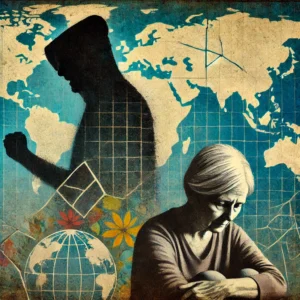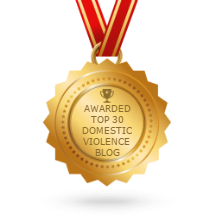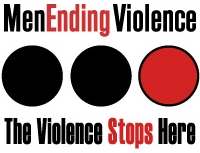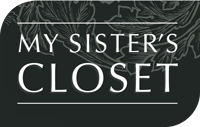Jan 8, 2025 | Battered Women's Support Services
Evan Vucci/The Associated Press
The escalating rhetoric from Donald Trump toward Canada has sent ripples through the political and economic spheres of both nations. With Prime Minister Justin Trudeau signaling his impending departure from leadership—though still holding office until a successor is chosen—the timing could not be more precarious. Trudeau’s pointed rebuttal on social media—”There isn’t a snowball’s chance in hell that Canada will become part of the United States”—highlights the intensity of the moment.
Yet beyond the viral soundbites, a deeper analysis is required to understand what’s at stake—not only for Canada’s economic and political stability but also for the lives and safety of marginalized groups, particularly women and Indigenous communities.
A Shocking Escalation—or a Predictable Pattern?
Historical Parallels: The Shadow of Manifest Destiny
While Trump’s bombastic rhetoric may feel unprecedented to many Canadians, it echoes deeply rooted patterns of American nationalism and expansionism, most famously embodied in the 19th-century concept of Manifest Destiny. This doctrine asserted that the United States was destined—by God and history—to expand its territory across North America, regardless of the sovereignty of neighboring nations or Indigenous peoples.
Though the language of Manifest Destiny faded from mainstream discourse, its spirit persists in slogans like “Make America Great Again.” For many Canadians, the suggestion of Canada becoming part of the United States feels absurd. However, for regions historically subject to American intervention—Latin America, Southeast Asia, and the Caribbean—this rhetoric serves as a chilling reminder of the power imbalance that continues to shape relationships between nations.
Provocation as Strategy: A Playbook of Chaos
Trump’s approach may seem erratic, but it follows a recognizable pattern: provoke, destabilize, and leverage chaos for negotiation. It’s a tactic that worked in trade disputes during his first term, including the imposition of steep tariffs on Canadian steel and aluminum.
The Economic Gendered Impact
It’s important to note that economic shocks caused by trade disputes are not gender-neutral. Women, particularly those employed in industries like manufacturing and agriculture, are often the first to face job losses or wage cuts. Economic vulnerability can increase reliance on abusive partners, reduce access to essential services, and exacerbate already precarious living conditions.
Canada’s Economic Vulnerabilities: A Double-Edged Sword
Interdependence as Both Strength and Weakness
Canada sends nearly 75% of its exports to the United States. This economic integration across key industries—automotive manufacturing, energy, and agriculture—means any disruption, rhetorical or real, can have devastating consequences. Trump’s threat of imposing 25% tariffs on key Canadian exports is not just economic posturing—it’s a genuine risk to jobs and livelihoods across Canada.
The Gendered Fallout of Economic Instability
Economic downturns disproportionately harm women and marginalized communities. When governments face fiscal constraints, funding for essential services such as shelters, counselling programs, and GBV prevention initiatives is often the first to be cut. These services are lifelines for survivors of domestic and sexual violence.
Call for Economic Diversification
Agreements like CETA (Comprehensive Economic and Trade Agreement) with Europe and CPTPP (Comprehensive and Progressive Agreement for Trans-Pacific Partnership) offer pathways to reduce reliance on U.S. trade. However, these agreements remain underutilized. Diversification isn’t just an economic priority—it’s a necessity for gender equity and social resilience.
Colonial Legacies and Structural Vulnerabilities
Canada’s Colonial Foundations: An Ongoing Crisis
Colonialism and imperialism are not relics of the past—they are active forces shaping Canada’s political and economic systems. Policies of displacement, resource extraction, and systemic discrimination continue to harm Indigenous communities, particularly women, girls, and Two-Spirit individuals.
Resource Extraction and GBV: A Deadly Connection
Large-scale resource extraction projects have long been associated with increased violence against women in nearby communities. The arrival of transient, male-dominated workforces, coupled with weakened community oversight, creates conditions ripe for exploitation and abuse.
Efforts to combat GBV cannot be separated from economic and resource policies. Protecting Indigenous women and girls requires robust environmental oversight, community-based safety initiatives, and meaningful consultation with Indigenous leaders.
Blue Gold: The Geopolitics of Water Resources in Canada
Freshwater Reserves in Canada: An Overlooked Vulnerability in the Race to the Bottom
Canada holds about 20% of the world’s freshwater reserves and 7% of its renewable freshwater flow, despite representing only 0.5% of the global population. This resource is increasingly seen as a geopolitical asset—and potential point of contention.
Historical and Modern Water Diversion Plans
Projects like the Grand Canal Project and NAWAPA (North American Water and Power Alliance) proposed redirecting Canada’s water southward. Though unrealized, these projects signal a persistent interest in Canadian water reserves, especially as droughts intensify across the United States.
In Indigenous communities, where water boil advisories are alarmingly common, women often bear the physical and emotional burden of securing clean water. Increased resource extraction or large-scale diversion projects would only deepen these inequalities, leaving women and girls more vulnerable to violence and exploitation.
Climate Emergency and Water Insecurity
As wildfires rage in Los Angeles, smothering skies with smoke, and British Columbia grapples with recurring heat domes that claim lives and strain infrastructure, the climate emergency grows ever more urgent. These events are not isolated—they are symptoms of a global water and climate crisis that policymakers seem paralyzed to address. Amid rising temperatures, depleted reservoirs, and vanishing snowpacks, Canada’s water resources will face unprecedented pressure. Yet, meaningful international collaboration to address these cascading crises feels increasingly out of reach, as political leaders focus on short-term gains instead of long-term resilience.
The Ripple Effect on Efforts to End Violence Against Women
Economic Instability and Intimate Partner Violence
When economies falter, social services often face cuts, shelters lose funding, and families face increased financial stress—all of which heighten the risk of intimate partner violence (IPV). For women in precarious employment, job losses can mean being trapped in abusive relationships.
Nationalist Rhetoric and Gendered Backlash
Trump’s leadership style, marked by divisive and often misogynistic rhetoric, emboldens extremist ideologies. Historically, nationalist movements have reinforced patriarchal norms, portraying feminist, and gender equity initiatives as distractions from “real” national priorities.
Resource Extraction and Vulnerability
Resource projects often exacerbate GBV risks in nearby communities. As Canada navigates economic tensions with the U.S., policymakers must ensure that economic strategies do not come at the expense of women’s safety.
Policy and Strategic Recommendations
Prioritize full implementation of agreements like CETA and CPTPP.
Safeguard funding for GBV prevention programs, even during economic downturns.
Classify water as a protected natural resource, not a tradable good, in future agreements.
Ensure Indigenous voices are central in decisions about trade, resource extraction, and water governance.
Build coalitions with U.S.-based feminist movements to counter divisive rhetoric.
A Call for Resilience and Equity
The intersection of economic instability, nationalist rhetoric, colonial legacies, and resource insecurity creates a precarious landscape for women and gender-diverse individuals in this land now know as Canada. Trump’s threats may seem distant from frontline efforts to end violence against women, but their ripple effects are undeniable.
Policymakers, advocates, and community leaders must recognize these connections. Protecting gender equity must remain central—not secondary—in Canada’s economic and diplomatic strategy.
As an organization dedicated to ending violence in all its forms, BWSS stands in solidarity with victims and survivors. For resources on safety, accessing support, and taking action against gender-based violence, visit our website.
You are not alone.
Call toll-free: 1-855-687-1868 Metro Vancouver: 604-687-1867 Email: EndingViolence@bwss.org
Dec 31, 2024 | Battered Women's Support Services

Matricide, the act of a son killing his mother, represents one of the most disturbing and tragic forms of gender-based violence. While statistically rare, it reveals a deeply entrenched intersection of mental health crises, misogyny, patriarchal values, and systemic failures. Matricide fits into the broader framework of femicide—the gender-based killing of women—and highlights societal blind spots in recognizing and addressing this unique form of violence.
The Canadian Femicide Observatory for Accountability and Justice (CFOAJ) tracks gender-related homicides and emphasizes the urgent need for systemic interventions. However, the lack of data disaggregation and limited global research specifically addressing son-to-mother killings obscure the scale and dynamics of this violence. This essay will analyze recent trends in matricide in Canada, discuss the role of misogyny and patriarchal structures in these killings, explore failures in institutional responses, compare Canadian cases to global trends, and emphasize the importance of policy reform and research to address this issue effectively
The term femicide, coined by Diana Russell in 1976, refers to the killing of women by men because they are women, rooted in misogyny and societal norms about gender roles. Over time, the definition has expanded to include feminicide, which emphasizes state accountability for failing to protect women and prosecute perpetrators.
Matricide, as a subset of femicide, remains underexamined and underacknowledged in global research. While international frameworks often include killings perpetrated by fathers, uncles, brothers, or cousins (e.g., UNODC, 2019; Weil et al., 2018), the category of sons as perpetrators remains largely overlooked. This omission is exacerbated by poor data disaggregation, making it difficult to determine the scale of son-mother killings internationally.
Emerging research suggests that parricide (the killing of a parent) is a stubborn phenomenon that remains consistent even during periods of declining homicide rates. Studies from England and Wales show that parricide averages between 18 and 22 cases per year (Bojanic et al., 2020; Holt, 2017; Miles, Condry, and Windsor, 2022). While women account for 27–30% of non-domestic homicide victims, they represent around 50% of all parricide victims, with mothers being disproportionately affected (Bojanic et al., 2020; Holt, 2017; Miles et al., 2022). Furthermore, 85–90% of parricide perpetrators are men, underscoring the gendered nature of this form of violence (Heide, 2013b; Miles et al., 2022).
This data highlights the critical need to recognize matricide as a distinct form of femicide shaped by misogyny, familial power dynamics, and institutional failures.
While matricide remains statistically rare in Canada, recent cases underscore recurring patterns of mental health struggles, misogyny, and institutional neglect:
- Pickering, Ontario (2024): A 64-year-old woman, Sheila Hercules, was assaulted and killed by her 25-year-old son. He was arrested and charged with second-degree murder.
- Toronto, Ontario (2022): Dallas Ly, 20, was charged with second-degree murder after the dismembered body of his mother, Tien Ly, was discovered. His trial revealed underlying resentment and mental health issues.
- Hamilton, Ontario (2023): Daryl Buckle, 34, was charged with first-degree murder following the death of his mother, Jacquelyne Buckle.
- Kamloops, British Columbia (2023): Brandon Donovan, 35, was charged with second-degree murder after the death of his mother, Jo-Anne Donovan.
- Halifax, Nova Scotia (2024): Jonathan Pinsky, 41, was charged with second-degree murder following the death of his mother, Delina Pinsky.
- Victoria, British Columbia (2022): Alexander James Thorpe was charged with the murder of his mother. The investigation revealed a history of untreated mental health issues and family dysfunction.
These cases demonstrate patterns of institutional failures to recognize risk, inadequacies in mental health care systems, and societal blindness to the gendered aspects of matricide.
The Role of Misogyny and Patriarchy in Matricide
Matricide cannot be understood without addressing the role of misogyny and patriarchal conditioning. Mothers are often seen through conflicting societal lenses: self-sacrificing nurturers, emotional caretakers, and moral authorities. These expectations place immense burdens on mothers while simultaneously positioning them as targets of blame and resentment.
- Scapegoating Mothers: Patriarchal values often position mothers as responsible for their sons’ failures. When men internalize societal messages about dominance and emotional suppression, their dependence on their mothers creates cognitive dissonance and fosters resentment.
- The Emotional Dependency Paradox: Sons may resent their reliance on their mothers while simultaneously feeling unable to break free from this dependence.
- Toxic Masculinity: Societal narratives framing caregiving and emotional vulnerability as feminine traits can cause sons to lash out violently when confronted with feelings of inadequacy.
- Institutional Blindness: Many systems fail to recognize the specific gendered risks mothers face when caring for adult sons with untreated or poorly managed mental health conditions.
Failures to Understand Risk to Mothers
Institutional reviews consistently highlight failures to understand and mitigate risks to mothers caring for violent or mentally ill sons:
- Failure to Identify Abuse: Incidents of property damage, threats, and previous violent outbursts were often overlooked or minimized by authorities.
- Poor Risk Assessments: In one case, a GP’s notes indicated that a son posed risks to female staff, yet he was allowed to live with his mother without any additional safety measures.
- Ignored Warnings: Mothers frequently voiced fears for their safety, and sons occasionally expressed concerns about harming their mothers, but these warnings were ignored.
- Isolation of Mothers: Mothers were often the sole caregivers, isolated from other support systems, and expected to monitor and report their sons’ behavior despite the clear risks involved.
- Psychotic Delusions: Symptoms such as persecutory ideations, command hallucinations, and Capgras syndrome were consistently identified as significant predictors of violence against mothers (Carabellese et al., 2014).
Mothers were frequently caught in a paradox of responsibility and marginalization—expected to act as primary caregivers while their safety concerns were dismissed or overlooked by professionals.
Global Trends and Comparative Analysis
Globally, matricide shares many patterns across different cultural contexts. In patriarchal societies with rigid gender norms, mothers are often scapegoated for their sons’ failures. In regions like Latin America, femicide rates remain alarmingly high, and feminicide frameworks emphasize state accountability for failing to protect women.
In contrast, Scandinavian countries have demonstrated success in reducing family violence through early intervention, mental health services, and robust social support systems. Canada can learn from these global models to address the societal and institutional factors contributing to matricide.
Recommendations for Addressing Matricide with a Focus on Support for Mothers of Adult or Youth Sons
To address matricide effectively and provide meaningful support to mothers of adult or youth sons, Canada must:
- Expand Mental Health Services for Families and Caregivers:
- Provide accessible, timely, and integrated mental health care specifically tailored for families, with targeted services for mothers caring for adult or youth sons experiencing mental health crises.
- Create specialized mental health programs that include family therapy, caregiver counseling, and crisis intervention services.
- Ensure mental health professionals are trained to recognize the unique challenges faced by mothers in caregiving roles.
- Improve Risk Assessment and Intervention Protocols:
- Develop and implement comprehensive risk assessment tools specifically focused on identifying risks to mothers of adult or youth sons exhibiting violent behavior or untreated mental health conditions.
- Ensure frontline workers, clinicians, and social service professionals are trained to recognize early warning signs of abuse, coercive control, and escalating risk in mother-son dynamics.
- Require follow-up protocols when concerning incidents (e.g., threats, property damage, violent outbursts) are reported, ensuring mothers’ concerns are taken seriously and acted upon promptly.
- Educate on Gendered Dynamics and Caregiver Burdens:
- Address societal narratives surrounding masculinity, caregiving roles, and emotional vulnerability through public education campaigns targeting boys, men, and families.
- Provide training for educators, social workers, and healthcare providers on the gendered dynamics of mother-son relationships, particularly in caregiving contexts.
- Challenge societal stigmas that discourage mothers from reporting abuse or seeking help due to fear of judgment or reprisal.
- Enhance Support Services for Mothers as Caregivers:
- Develop targeted support programs specifically for mothers caring for adult or youth sons with severe mental health conditions or behavioral concerns.
- Provide financial assistance, respite care services, and peer support groups for mothers who often bear disproportionate caregiving responsibilities.
- Establish helplines and crisis intervention services specifically designed for mothers experiencing fear or violence from their sons.
- Implement safety planning protocols for mothers living with at-risk sons, ensuring they have access to emergency housing and secure environments if needed.
- Improve Data Collection and Research on Matricide:
- Mandate the disaggregation of homicide data to specifically track matricide cases, including contextual information on perpetrators’ mental health history, caregiving dynamics, and previous warning signs.
- Conduct in-depth research on the lived experiences of mothers caring for at-risk adult or youth sons to better understand systemic gaps and inform evidence-based policy interventions.
Encourage collaboration between academic researchers, government agencies, and non-profits to analyze data trends and identify effective prevention strategies.
Matricide is not merely an isolated tragedy—it is a stark reflection of deeply entrenched societal and institutional failures rooted in misogyny, patriarchal power structures, and systemic neglect. It is a hidden form of femicide, shaped by gendered expectations that simultaneously idealize and scapegoat mothers, leaving them vulnerable to both familial and institutional violence. The invisibility of mothers as victims of femicide reflects not only societal indifference but also a state-level failure to recognize and address the risks they face.
To dismantle these harmful dynamics, Canada must boldly confront the patriarchal ideologies that normalize women’s caregiving burdens while ignoring the dangers they face in those roles. Recognizing matricide as a distinct and gendered form of femicide is not just an academic exercise—it is a political imperative. Addressing this violence requires systemic changes in mental health services, risk assessment protocols, and caregiver support systems, paired with a broader cultural shift that challenges the gendered assumptions perpetuating this violence.
Women deserve to be seen, heard, and protected—not just as mothers, but as individuals whose lives hold intrinsic value beyond their caregiving roles. Ending matricide means dismantling the structures of power and silence that allow it to persist. It is time to center mothers’ voices, prioritize their safety, and hold both perpetrators and the systems that fail them accountable. Only then can Canada move towards a society where no mother fears violence from her son, and every woman’s life is valued and protected.
Dec 29, 2024 | Battered Women's Support Services

If American politics were a reality TV show—and let’s face it, it basically is—this season’s main event would be the immigration smackdown between MAGA populists and Silicon Valley tech bros. In one corner: flag-waving patriots chanting, “Build the wall!” In the other: hoodie-clad billionaires whispering, “But who will code our apps for half the salary?” And just when we thought this circus was U.S.-only, Canada casually steps in, holding its signature “Nice Guy” reputation while echoing familiar anxieties about immigrants “taking jobs” and “threatening values.”
At the core of these debates lies the same patriarchal power play. MAGA fears brown men taking “manly” jobs in construction and agriculture, while tech bros exploit immigrant labour under programs like H-1B visas in the U.S. and Global Talent Stream in Canada. Both sides claim immigration is about national prosperity, but neither seems particularly invested in the dignity, equity, or humanity of the people at the centre of it.
MAGA, Tech Bros, and the Gendered Labour Market
MAGA’s anxieties aren’t really about immigration; they’re about preserving the fantasy of the rugged, self-reliant American (or Canadian) man. Immigrant men in fields like construction, farming, or manufacturing challenge this illusion. Meanwhile, narratives about “dangerous immigrant men threatening our women” continue to fuel anti-immigrant sentiment on both sides of the border, regardless of evidence.
In tech, the exploitation is less loud but just as exploitative. Immigrant workers in Silicon Valley and Canadian tech hubs like Toronto and Vancouver are trapped in cycles of visa dependency, overwork, and underpayment. Tech CEOs love to parade “diversity” slogans, but the industry remains overwhelmingly white and male.
And here’s where the gendered angle sharpens: Indigenous, Black, and racialized women remain almost entirely locked out of STEM opportunities. Despite high-profile initiatives claiming to advance diversity, women from these communities face systemic exclusion, wage disparities, and barriers to leadership. In Canada, Indigenous women are particularly underrepresented in STEM fields due to colonial systems of exclusion, underfunded education, and systemic racism.
Even when women of colour do enter these industries, they are more likely to be confined to lower-level positions with limited upward mobility. Instead of climbing the ladder, they’re often handed “mentorship opportunities”—a euphemism for being politely kept out of decision-making spaces.
Tariffs, Trump, and the Hidden Costs of Immigration Policy
Immigration policy doesn’t exist in a vacuum—it’s tangled up with trade deals, tariffs, and economic pressures. Recently, high-ranking Canadian officials met with top aides to Donald Trump to discuss border security and the potential impact of the 25% tariffs that the president-elect has threatened to impose when he takes office next month. Previously, under Donald Trump’s presidency, immigration crackdowns weren’t just about border walls and travel bans; they were paired with tariffs on imports from countries like Mexico and China. These tariffs increased economic instability in the very regions where people were most likely to migrate in search of security and opportunity.
Meanwhile, Canada often frames itself as a more humane alternative to Trump-style immigration policies. But in reality, Canada’s reliance on programs like the Temporary Foreign Worker Program (TFWP) mirrors the U.S. system’s reliance on precarious immigrant labour. Workers—many of them women—are brought in to fill low-wage jobs, only to face exploitative conditions, wage theft, and limited pathways to citizenship.
Tariffs and immigration restrictions, whether in the U.S. or Canada, don’t reduce migration—they make it riskier, more exploitative, and more profitable for the powerful.
Feminist Analysis and Real Accountability
Both MAGA populists and tech capitalists approach immigration as a power game. MAGA wants immigrants out, while tech wants them in—but only under exploitative conditions. Canada often frames its immigration system as progressive, but systemic inequities in labour rights, wage equity, and representation in high-paying industries paint a more complex picture.
A feminist immigration policy would go beyond border security and visa quotas. It would:
- Prioritize human rights and dignity for all immigrants, regardless of status.
- Address the intersectional barriers faced by Indigenous, Black, and racialized women in accessing economic and educational opportunities.
- Ensure labour rights protections are not tied to visa status.
- Tackle the economic pressures created by tariffs and exploitative trade policies that drive migration under desperate conditions.
- Include immigrant women’s voices in policy-making spaces, ensuring they have a seat at the table—not just token representation.
The Final Word: Immigration Isn’t a Chessboard
Here’s a thought: What if we stopped treating immigration like a chessboard where powerful white men move brown and Black pieces around to serve their own agendas? Immigration policy isn’t about borders, innovation, or economic stability—it’s about power, profit, and control.
While MAGA hats, tech hoodies, and Canadian policy briefs wrapped in polite branding keep dominating the conversation, feminists will be here—with research reports, community coalitions, and unshakable resolve—fighting for an immigration system built on equity, dignity, and humanity.
And if anyone wants to join us, great. But they’ll need to show up ready to listen, commit to meaningful action, and leave performative gestures behind.
by Angela Marie MacDougall, executive director, BWSS Battered Women’s Support Services










